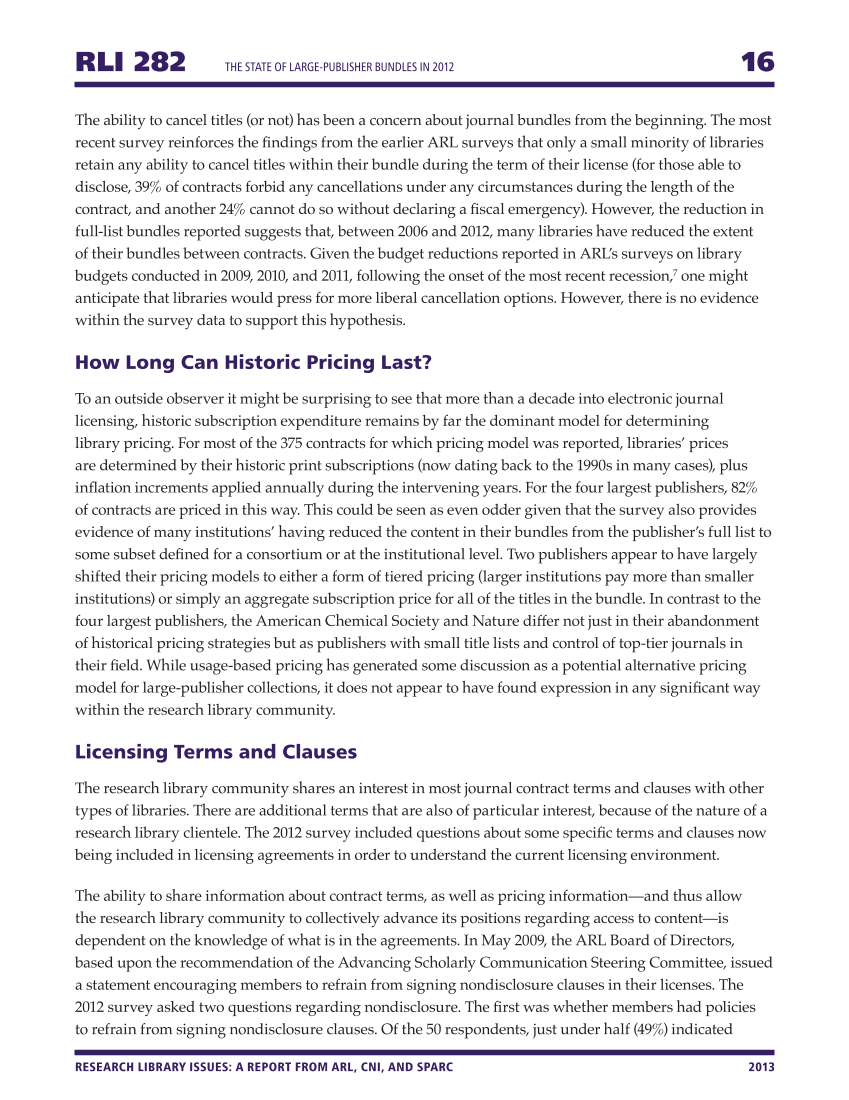RLI 282 The State of Large-Publisher Bundles in 2012 16 RESEARCH LIBRARY ISSUES: A REPORT FROM ARL, CNI, AND SPARC 2013 The ability to cancel titles (or not) has been a concern about journal bundles from the beginning. The most recent survey reinforces the findings from the earlier ARL surveys that only a small minority of libraries retain any ability to cancel titles within their bundle during the term of their license (for those able to disclose, 39% of contracts forbid any cancellations under any circumstances during the length of the contract, and another 24% cannot do so without declaring a fiscal emergency). However, the reduction in full-list bundles reported suggests that, between 2006 and 2012, many libraries have reduced the extent of their bundles between contracts. Given the budget reductions reported in ARL’s surveys on library budgets conducted in 2009, 2010, and 2011, following the onset of the most recent recession,7 one might anticipate that libraries would press for more liberal cancellation options. However, there is no evidence within the survey data to support this hypothesis. How Long Can Historic Pricing Last? To an outside observer it might be surprising to see that more than a decade into electronic journal licensing, historic subscription expenditure remains by far the dominant model for determining library pricing. For most of the 375 contracts for which pricing model was reported, libraries’ prices are determined by their historic print subscriptions (now dating back to the 1990s in many cases), plus inflation increments applied annually during the intervening years. For the four largest publishers, 82% of contracts are priced in this way. This could be seen as even odder given that the survey also provides evidence of many institutions’ having reduced the content in their bundles from the publisher’s full list to some subset defined for a consortium or at the institutional level. Two publishers appear to have largely shifted their pricing models to either a form of tiered pricing (larger institutions pay more than smaller institutions) or simply an aggregate subscription price for all of the titles in the bundle. In contrast to the four largest publishers, the American Chemical Society and Nature differ not just in their abandonment of historical pricing strategies but as publishers with small title lists and control of top-tier journals in their field. While usage-based pricing has generated some discussion as a potential alternative pricing model for large-publisher collections, it does not appear to have found expression in any significant way within the research library community. Licensing Terms and Clauses The research library community shares an interest in most journal contract terms and clauses with other types of libraries. There are additional terms that are also of particular interest, because of the nature of a research library clientele. The 2012 survey included questions about some specific terms and clauses now being included in licensing agreements in order to understand the current licensing environment. The ability to share information about contract terms, as well as pricing information—and thus allow the research library community to collectively advance its positions regarding access to content—is dependent on the knowledge of what is in the agreements. In May 2009, the ARL Board of Directors, based upon the recommendation of the Advancing Scholarly Communication Steering Committee, issued a statement encouraging members to refrain from signing nondisclosure clauses in their licenses. The 2012 survey asked two questions regarding nondisclosure. The first was whether members had policies to refrain from signing nondisclosure clauses. Of the 50 respondents, just under half (49%) indicated


























